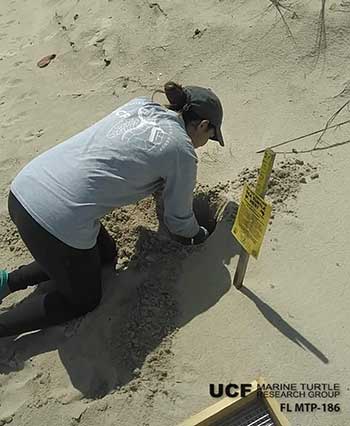Grant: 21-009R
Project Title: Late-Season Sea Turtle Nesting in Central and South Brevard County, Florida
Project Manager: Erin E. Seney, Ph.D.
Organization: University of Central Florida (Research and Educational Institute)
Grant Amount: $8,963.00
Completion Date: 2022-06-06
Summary: The University of Central Florida Marine Turtle Research Group (UCF MTRG) monitors sea turtle nesting activity and hatchling output on densely-nested beaches spanning 47.5 km (29.5 miles) of Central and South Brevard County and UCF marks about 750-1,100 nests annually. Loggerhead nesting in UCF’s survey region typically extends into September, whereas green turtle nesting extends into October-November, but the program’s nest marking schemes are designed to be representative of each species’ nesting season. During 2016-2020, 93% of UCF’s marked loggerhead nests were laid in May-July, and 90% of marked green turtle nests were laid in June-August. Both species’ nests typically incubate for about 50-55 days on UCF beaches, but incubation durations vary with temperature and precipitation. In cooler years, late-season nests take longer to incubate, and some nests may slow or suspend development and ultimately hatch in the spring. It is the late-season nests that are most likely to overlap with dune restoration and beach nourishment. In Brevard County, sand placement activities typically occur during November-March, with some projects extending into spring. Nests laid within 65 days of a beach project start date are either marked for avoidance or relocated outside of the construction area. The state- and federally-required 65-day timeframe is based on limited late-season data and is necessarily conservative to avoid harm to federally protected nests or hatchlings. This project will increase the number of September-November nests marked, monitored, and inventoried by the UCF MTRG to fill knowledge gaps for late-season nests to better inform management agencies.  Results: Though sea turtle nesting on Florida’s east coast extends nearly year-round, nests laid in the last months of the loggerhead (Caretta caretta) and green turtle (Chelonia mydas) nesting season, especially after the official “end” of the season (October 31), are historically understudied. Late-season nests are the most likely to be impacted by beach renourishment projects typically occurring from November-March. These nests are also exposed to lower temperatures, which will slow egg incubation duration and may reduce nest viability and hatching success. With the recent increase in green turtle nesting, it is likely that late-season nests will become more common and may have an important contribution to population dynamics. The beaches monitored by the University of Central Florida’s Marine Turtle Research Group (UCF MTRG) in south and central Brevard County are representative of nesting in the state, hosting about 1 in 6 loggerhead and 1 in 3 green turtle nests, making them an optimal study area. In 2021, the UCF MTRG supplemented its reproductive sampling scheme to include more late-season nests. In addition to our normal subsample, we marked 8 loggerhead and 46 green turtle nests in September and October, and all nests in November. In total, 9 loggerhead and 69 green turtle nests were marked during 1 September- 15 November 2021, comprising 100% of September loggerhead and 53% of green turtle nests documented in October through mid-November. Inventory data collected from these extra marked nests will be used to describe incubation duration, viability, and reproductive success by species, compared to peak season (April-August) nests. Results from this research will be useful for determining the contributions of late-season nests to reproductive output, as well as informing nest inventory protocols during cooler months and aiding managers overseeing beach construction and seasonal beach restrictions.
Results: Though sea turtle nesting on Florida’s east coast extends nearly year-round, nests laid in the last months of the loggerhead (Caretta caretta) and green turtle (Chelonia mydas) nesting season, especially after the official “end” of the season (October 31), are historically understudied. Late-season nests are the most likely to be impacted by beach renourishment projects typically occurring from November-March. These nests are also exposed to lower temperatures, which will slow egg incubation duration and may reduce nest viability and hatching success. With the recent increase in green turtle nesting, it is likely that late-season nests will become more common and may have an important contribution to population dynamics. The beaches monitored by the University of Central Florida’s Marine Turtle Research Group (UCF MTRG) in south and central Brevard County are representative of nesting in the state, hosting about 1 in 6 loggerhead and 1 in 3 green turtle nests, making them an optimal study area. In 2021, the UCF MTRG supplemented its reproductive sampling scheme to include more late-season nests. In addition to our normal subsample, we marked 8 loggerhead and 46 green turtle nests in September and October, and all nests in November. In total, 9 loggerhead and 69 green turtle nests were marked during 1 September- 15 November 2021, comprising 100% of September loggerhead and 53% of green turtle nests documented in October through mid-November. Inventory data collected from these extra marked nests will be used to describe incubation duration, viability, and reproductive success by species, compared to peak season (April-August) nests. Results from this research will be useful for determining the contributions of late-season nests to reproductive output, as well as informing nest inventory protocols during cooler months and aiding managers overseeing beach construction and seasonal beach restrictions.